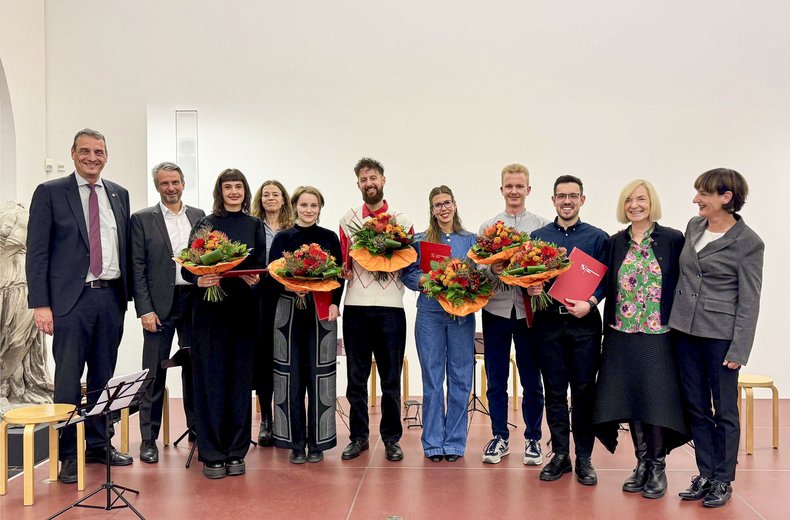On November 5, 2025, the winners of this year’s Gutenberg Scholarship of the City of Mainz were announced at the Landesmuseum Mainz. Three projects from Mainz University of Applied Sciences received an award. The scholarship is awarded to completed academic works that are considered an outstanding scientific, artistic, or professional achievement and are thematically related to the state capital of Mainz. For the year 2025, the city awarded five scholarships to a total of six graduates: three for theses at Mainz University of Applied Sciences and two for theses at Johannes Gutenberg University. The topics covered a broad spectrum, ranging from geoinformation, surveying, and communication design to interior architecture, chemistry, pharmacy, geography, and geosciences to fine arts and art education.
“I am delighted that three theses from Mainz University of Applied Sciences have been awarded this year’s Gutenberg Scholarship by the City of Mainz. As a university of applied sciences, it is particularly important to us to translate knowledge into concrete solutions, creative innovations, and socially relevant projects. We are particularly proud that our students have succeeded in doing this in such an outstanding way,” emphasizes Prof. Dr. Susanne Weissman, President of Mainz University of Applied Sciences.
The award-winning theses at a glance:
Mainzer Unterwelten – 3D-Aufmaß und Visualisierung des unterirdischen Kontereskarpengangs am Fort Josef (Mainz Underworlds – 3D Survey and Visualization of the Underground Counterscarp Passage at Fort Josef)
Jan Hechtelberger and Tobias Altmaier | School of Engineering
Thesis Advisor | Dipl.-Ing. Margaritha Vogt
In their bachelor’s thesis, Jan Hechtelberger and Tobias Altmaier investigated the historical structure of the counterscarp passage at Fort Josef, an underground passageway that was built to defend the fortress walls. The aim of their project was to conduct a complete underground and above-ground 3D survey of the passage and the terrain above it, and to produce precise plans such as floor plans, longitudinal and cross-sections using BricsCAD and CloudWorx. In addition to demonstrating the potential of digital surveying techniques, the thesis also offers practical solutions for future 3D visualizations, such as using web models or 3D printing. The students also discussed methodological challenges, including selecting suitable software, optimizing laser scans, and possible further developments for the detailed mapping of historical buildings.
Rhein hören: Stromkilometer 497,5 (Hear About the Rhine: River Kilometer 497.5)
Stella Eckhardt | School of Design
Thesis Advisor | Prof. Monika Aichele
Stella Eckhardt’s master’s thesis in Communication Design invites visitors to take a seat on a blue bench by the Rhine in Mainz and embark on a digital stroll through stories, facts, and figures about the Rhine. On the corresponding website, visitors can discover the Rhine using an interactive map and audio guides. The project is a symbiosis of urban intervention and digital knowledge transfer with a direct link to Mainz. Using the Rhine as an example, it shows how science communication can be made more accessible in public spaces. The blue bench was an interactive station on the banks of the Rhine in Mainz at the opening festival of the Summer of Culture in April 2025 and invited visitors to take digital excursions.
Matriarchy in Mainz: Kunst und Kultur von Frauen für Frauen (Matriarchy in Mainz: Art and Culture by Women for Women)
Mareen Helene Ohrt | School of Design
Thesis Advisor| Prof. Alexa Hartig and Prof. Lutz Büsing
In her bachelor’s thesis, Mareen Helene Ohrt developed an innovative architectural concept for the Allianzhaus in Mainz. Her design integrates cultural offerings for the public on the first floor, including a movie theater, gallery, café, workshops, and courses, with an artist’s residency for women and associated workshops on the upper floors. Her thesis focuses on the visibility and promotion of women in art and culture to counterbalance structural disadvantages and introduce women’s perspectives into urban development. At the same time, the design links the residency to the public spaces: Women artists present their works, hold courses, and play an active role in shaping cultural life, creating a lively exchange between the residency and the public.




